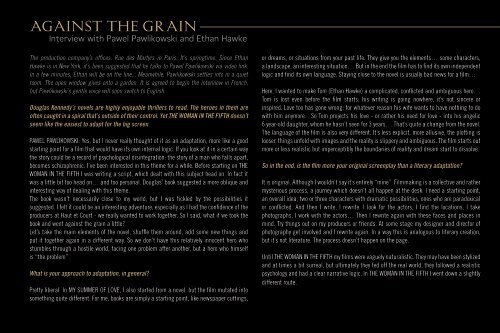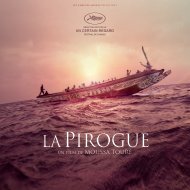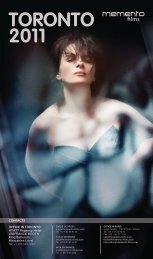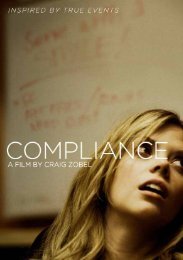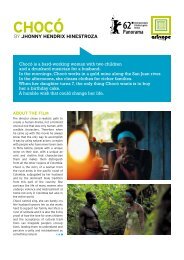Press Kit - Memento Films International
Press Kit - Memento Films International
Press Kit - Memento Films International
You also want an ePaper? Increase the reach of your titles
YUMPU automatically turns print PDFs into web optimized ePapers that Google loves.
AGAINST THE GRAIN<br />
Interview with Pawel Pawlikowski and Ethan Hawke<br />
The production company’s offices, Rue des Martyrs in Paris. It’s springtime. Since Ethan<br />
Hawke is in New York, it’s been suggested that he talks to Pawel Pawlikowski via video link.<br />
In a few minutes, Ethan will be on the line... Meanwhile, Pawlikowski settles into in a quiet<br />
room. The open window gives onto a garden. It is agreed to begin the interview in French,<br />
but Pawlikowski’s gentle voice will soon switch to English.<br />
Douglas Kennedy’s novels are highly enjoyable thrillers to read. The heroes in them are<br />
often caught in a spiral that’s outside of their control. Yet THE WOMAN IN THE FIFTH doesn’t<br />
seem like the easiest to adapt for the big screen.<br />
PAWEL PAWLIKOWSKI: Yes, but I never really thought of it as an adaptation, more like a good<br />
starting point for a film that would have its own internal logic. If you look at it in a certain way<br />
the story could be a record of psychological disintegration: the story of a man who falls apart,<br />
becomes schizophrenic. I’ve been interested in this theme for a while. Before starting on THE<br />
WOMAN IN THE FIFTH I was writing a script, which dealt with this subject head on. In fact it<br />
was a little bit too head on… and too personal. Douglas’ book suggested a more oblique and<br />
interesting way of dealing with this theme.<br />
The book wasn’t necessarily close to my world, but I was tickled by the possibilities it<br />
suggested. I felt it could be an interesting adventure, especially as I had the confidence of the<br />
producers at Haut et Court - we really wanted to work together. So I said, what if we took the<br />
book and went against the grain a little?<br />
Let’s take the main elements of the novel, shuffle them around, add some new things and<br />
put it together again in a different way. So we don’t have this relatively innocent hero who<br />
stumbles through a hostile world, facing one problem after another, but a hero who himself<br />
is “the problem”.<br />
What is your approach to adaptation, in general?<br />
Pretty liberal. In MY SUMMER OF LOVE, I also started from a novel, but the film mutated into<br />
something quite different. For me, books are simply a starting point, like newspaper cuttings,<br />
or dreams, or situations from your past life. They give you the elements… some characters,<br />
a landscape, an interesting situation… But in the end the film has to find its own independent<br />
logic and find its own language. Staying close to the novel is usually bad news for a film…<br />
Here, I wanted to make Tom (Ethan Hawke) a complicated, conflicted and ambiguous hero…<br />
Tom is lost even before the film starts: his writing is going nowhere, it’s not sincere or<br />
inspired. Love too has gone wrong; for whatever reason his wife wants to have nothing to do<br />
with him anymore... So Tom projects his love - or rather his need for love - into his angelic<br />
6 year-old daughter, whom he hasn’t seen for 3 years… That’s quite a change from the novel.<br />
The language of the film is also very different. It’s less explicit, more allusive, the plotting is<br />
looser, things unfold with images and the reality is slippery and ambiguous. The film starts out<br />
more or less realistic but imperceptibly the boundaries of reality and dream start to dissolve.<br />
So in the end, is the film more your original screenplay than a literary adaptation?<br />
It is original. Although I wouldn’t say it’s entirely “mine”. Filmmaking is a collective and rather<br />
mysterious process, a journey which doesn’t all happen at the desk. I need a starting point,<br />
an overall idea, two or three characters with dramatic possibilities, ones who are paradoxical<br />
or conflicted. And then I write, I rewrite. I look for the actors, I find the locations, I take<br />
photographs, I work with the actors… Then I rewrite again with these faces and places in<br />
mind. Try things out on my producers or friends. At some stage my designer and director of<br />
photography get involved and I rewrite again. In a way this is analogous to literary creation,<br />
but it’s not literature. The process doesn’t happen on the page.<br />
Until THE WOMAN IN THE FIFTH my films were vaguely naturalistic. They may have been stylized<br />
and at times a bit surreal, but ultimately they fed off the real world, they followed a realistic<br />
psychology and had a clear narrative logic. In THE WOMAN IN THE FIFTH I went down a slightly<br />
different route.<br />
You’re flirting with the codes of genre movies.<br />
I’m not sure whether “flirting” is the right way to describe it. Horror or suspense films are shot<br />
in such a way that the viewer quickly soon realizes what the game is. THE WOMAN IN THE FIFTH<br />
doesn’t give you these any genre handles, doesn’t signal anything clearly, things become<br />
strange and scary quite imperceptibly… I tried to be as discreet as possible… In some ways<br />
THE WOMAN IN THE FIFTH is a new departure, but at the same time, it’s not so different from<br />
my other films: few carefully chosen locations, not too much plot, the situations and images<br />
are a little stylised but they feed off a concrete reality and a landscape. And there’s always one<br />
main character through whom we see the world.<br />
Here, this world is Paris. The Paris you film is indeed strange, but it feels very original and<br />
very true to life.<br />
I tend to use landscape as a mental space. I did that even in my documentaries. I’m not<br />
so much interested in the world as it is, or in paying homage to a particular place. I never<br />
wanted to show Paris, no more than I wanted to show the real Yorkshire, or the Kent coast<br />
in my earlier films. So I’m always really surprised when people come to me after seeing my<br />
films and tell me how much I really “got” these places, places they’ve known all their lives,<br />
but never saw properly shown on the screen.<br />
I use real locations but I strip them down and make them strange in a certain way. I’m always<br />
trying to get at something timeless, dream-like or nostalgic. The hero’s emotional state is the key.<br />
It’s through him that we see the world. I really like Paris. And to be honest, I don’t see it in<br />
real life the same way I show it in the film. Even when I was young, broke and out on a limb,<br />
Paris always seemed welcoming. But let’s face it, this film isn’t really about Paris.<br />
The problem with Paris is that it’s really difficult to find places where it doesn’t look like some<br />
cliché of itself. It’s hard… Wherever you look, you have these white or off-white, creamy buildings.<br />
The doorframes, the windows, the cafés, all so Parisian!... And it’s so lively and colourful<br />
everywhere. I spent a lot of time with my adventurous set designer Benoît Barouh,<br />
criss-crossing the city on his scooter, scouring it for something unusual, something that would<br />
ring a bell... I wanted a Paris that wasn’t really Paris. I needed some 1970s Eastern Europe!<br />
You have made a lot of documentaries, also very much in your own style. Do you ever want<br />
to return to that?<br />
I wouldn’t mind. But the world I was interested in has disappeared. And anyway I don’t think<br />
there’s much call these days for the sort of documentaries I used to make. For me documentary<br />
was never about explaining the world didactically, or just humbly recording it, but more about<br />
looking at the world against the grain, making it less obvious, more troubling, mysterious,<br />
distilling it in some way, through the right image, sound, editing… It takes lots of time,<br />
patience and effort to film the right situation, the right moment, something revealing,<br />
unique or beautiful, from the right angle, in the right light. These days, in an age of total<br />
communication, images are dozen to a penny and everything has to be spelt out, rammed<br />
down your neck. There are of course noble exceptions, documentary fanatics like Dvortevoi<br />
or Kossakovsky, but generally documentaries are aimed at the TV, or they have to lure large<br />
audiences into the cinema, so obviously they have to conform to certain rules or formats.<br />
Obliqueness, ambiguity, poetry are not much in demand these days.<br />
I remember Kieslowski telling me over a drink some thirty years ago: “Shoot each film as<br />
if it were your last. Or do something else!” This is what I tend to do. So here I am with<br />
THE WOMAN IN THE FIFTH, this strange hybrid creature I love.<br />
You’re Polish, you live in London, you’ve never really lived in Paris. Do you feel an affinity<br />
with this man for whom everything in the city is foreign, and who’s very alone?<br />
It’s a situation I’m familiar with. You arrive somewhere new and big, where you don’t know the<br />
rules of the game, the ins and outs of the language; one minute you feel cocky and triumphant,


